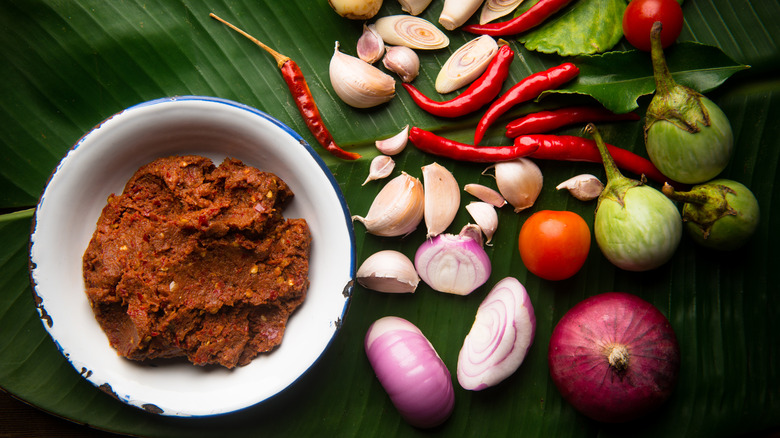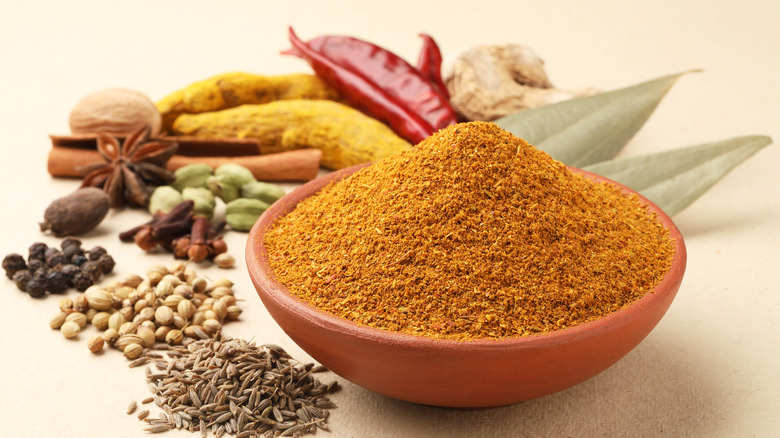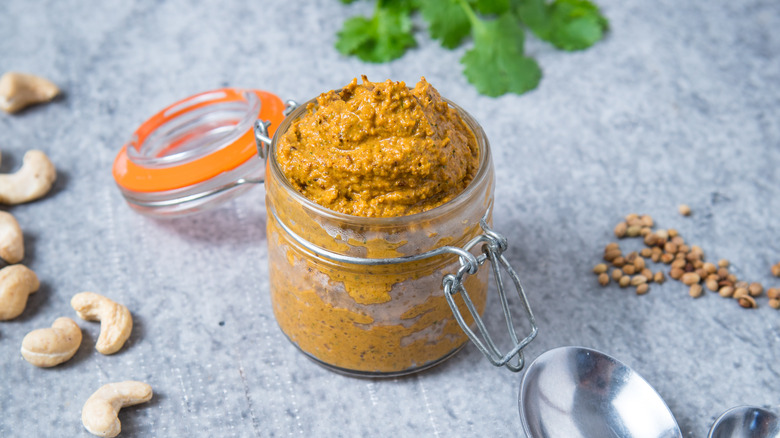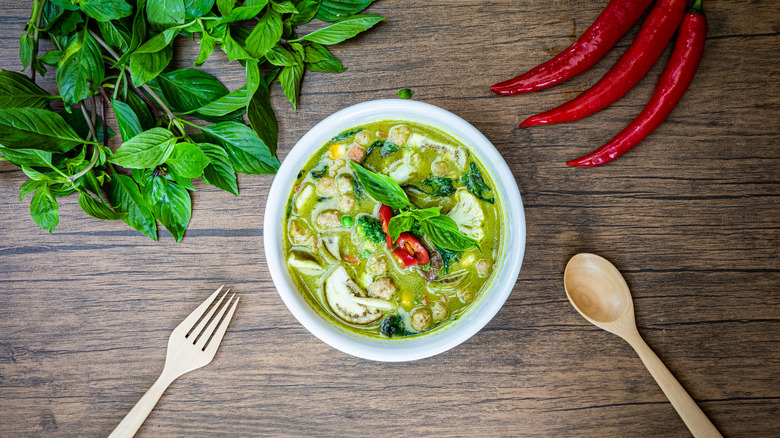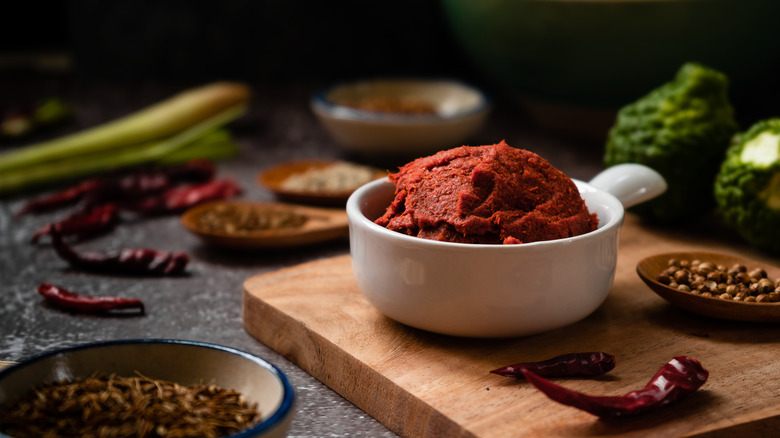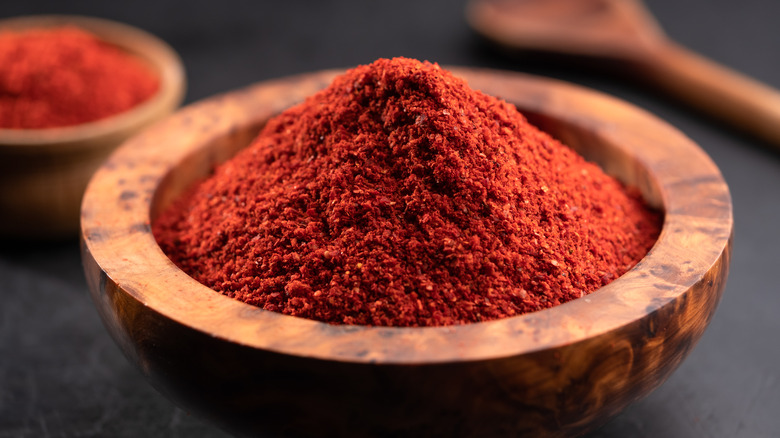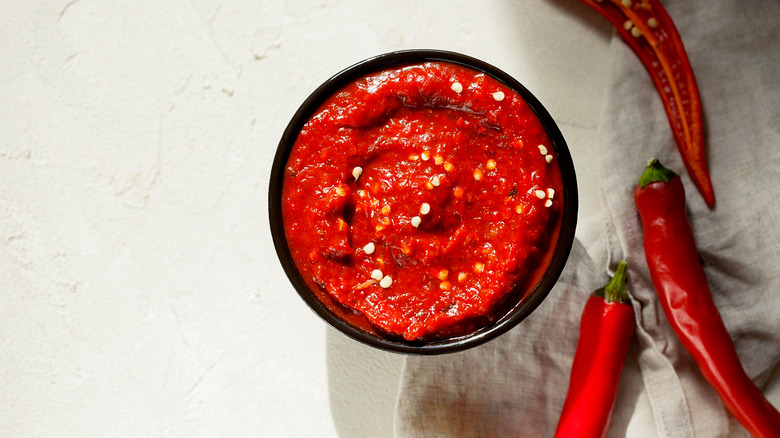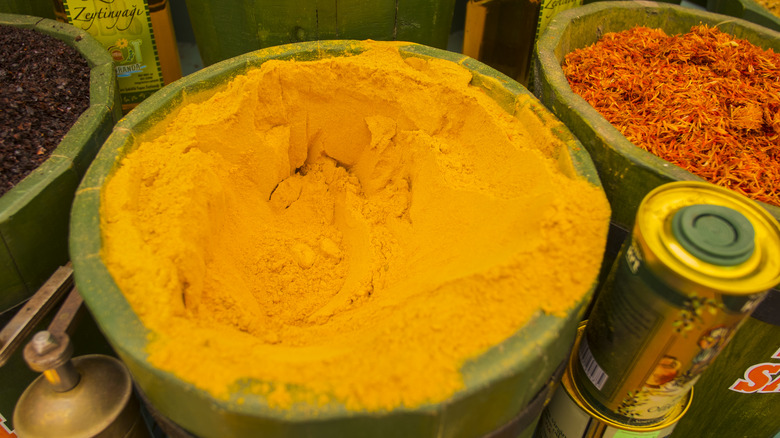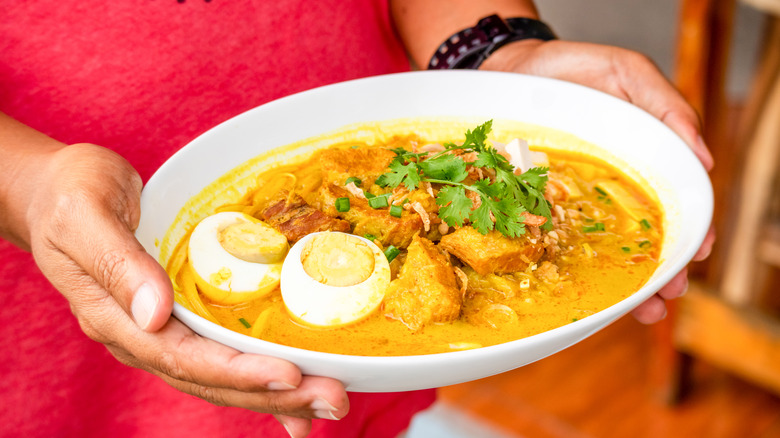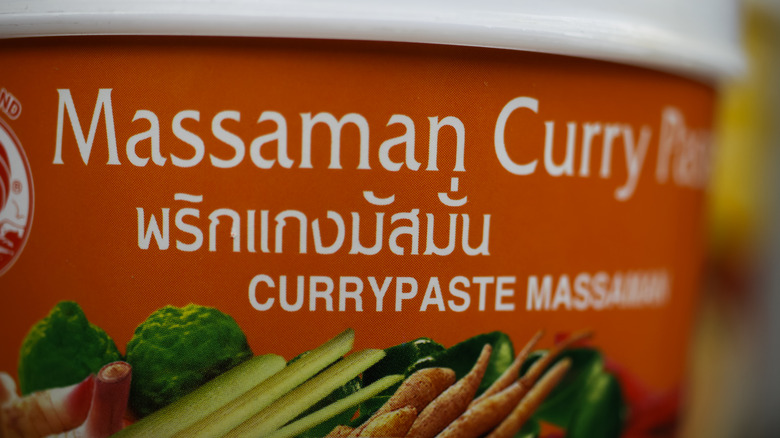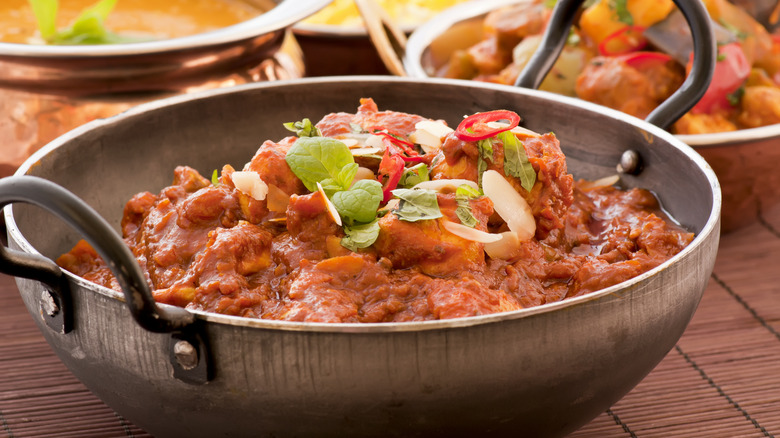10 Best Substitutes For Red Curry Paste
Red curry is an incredibly delicious, comforting dish to whip up on busy nights, but it's also a great way to use up any items you have in your fridge. If you like a little extra protein, you can toss in additions like diced chicken breast, shrimp, or tofu. If you prefer a vegetable-based dish packed with flavor, you can mix some red curry paste together with leftover produce you have in your fridge to make a decadent meal that's overflowing with a variety of textures. How much coconut milk you use defines how creamy your red curry ends up being, and you can serve it up over any kind of grain, as a stand-alone meal, or any other way you like. The options are truly endless — red curry is an incredibly versatile dish to have in your culinary repertoire.
While the ingredients within a curry are quite flexible and can be customized to whatever you personally prefer, one key ingredient defines the taste of the dish — the flavor-packed spice paste. This base comes in small jars that you'll find nestled along the shelves of your grocery store and are bursting with aromatics and seasoning, including red chili peppers, turmeric, ginger, coriander seeds, and more. Without this central ingredient, it can be a little intimidating to know where to start. Luckily, there are a few good substitutes that you can consider if you find yourself craving red curry but lack the proper paste.
1. Curry powder
While there is no such thing as a dried version of red curry paste, there is curry powder, which captures some of the same flavor notes. Thai red curry paste does have a different flavor profile when compared to a dry spice blend, so you won't get exactly the same luxurious taste or red color in your meal, and you may need to taste your dish as it cooks and add a bit more seasoning if you think it needs it.
But in a pinch, this substitute does a pretty good job of infusing that signature red curry flavor into your dish. When it comes to using this seasoning, you want to be careful not to overpower whatever you cook. For best results, use about one teaspoon of curry powder for every one tablespoon of paste your recipe calls for. As long as you feel okay with a less-red dish, you can't go wrong with this substitute.
2. Yellow curry paste
If you're looking for a red curry substitute, the alternate colors of this seasoning base are actually one of the best places to look, especially the yellow version. After all, red and yellow curry pastes are different in more ways than just their hue — they each have a slightly different balance of flavors thanks to the yellow version's use of turmeric and curry powder. In fact, the yellow version gets its signature hue thanks to the addition of turmeric, and unlike its red cousin, which gets its color from dried red chiles, the yellow paste is a bit milder.
The substitute's consistency is the same, so you shouldn't have any issues with incorporating it into your dish. However, depending on the amount used, it may change up the color of your meal and will likely not be quite as spicy. So, decide whether it matters if your stew or sauce requires a slightly more yellow color and consider adding a few extra hits of spice to amp up that heat level if that's important to you. For best results, you can do a direct substitution, using two tablespoons of yellow curry paste in place of two tablespoons of red curry paste.
3. Green curry paste
Between red, yellow, and green curry pastes, green versions of the spice blend pack the most heat, as this version gets its signature shade from the inclusion of green chili peppers, such as serrano peppers. The classic red seasoning paste also packs a decent punch when it comes to bringing the heat, so the green variety makes an ideal substitute for red curry paste if you don't happen to have the latter on hand.
Of course, the one major difference between red curry and green curry is the color. Larger amounts of the red paste will give a distinct red hue to your dish, while green curry paste colors your recipe with a green shade. This is important to consider if you're particular about the appearance of your meal. If you're just after great flavor, though, substitute away. Since the two are similar in heat level and consistency, you can do a direct swap, adding two tablespoons of green curry paste in place of two tablespoons of red curry paste.
4. DIY red curry paste
When you're looking for a quick, convenient substitute in a pinch, chances are good that you'd prefer to just find something in your pantry rather than whip up a homemade swap. But given the depth of flavor that red curry contains, sometimes creating your own homemade version is the best way to ensure your dish tastes right.
There are countless recipes for red curry paste, with everyone adding their own flair and particular spices. Stonesoup has a version that contains ingredients you likely already have at home if you enjoy cooking and have a reasonably well-stocked fridge and pantry. To make four to five tablespoons of DIY red curry paste, which should be enough for most recipes, you just need to puree two tablespoons of neutral oil like grapeseed oil, four to six peeled garlic cloves, a thumb-sized piece of chopped ginger, six large red chili peppers, and either three stalks of lemongrass or the zest of one lemon together. Once you've created your mixture, you can do a direct swap, using the same amount of the homemade version that your recipe calls for.
5. Chili powder
You probably have a container of chili powder hanging around in your spice cabinet, but it's not what you would first think to reach for when seeking a substitute for red curry paste. However, if you're crafting a dish where that element of heat is one of the most important factors, chili powder just might be the right substitute for you. As an added bonus, chili powder gives your dish a bit of a crimson hue, mimicking the coloring your cuisine gets from the normal red variety.
The downside of this substitute is that without the other spices and aromatics present in red curry paste, it really only brings the heat to your dish. You'll likely want to give your dish a taste after adding this powder and perhaps consider incorporating a few other spices or seasonings to round out the flavor profile of your culinary creation. For best results, avoid being heavy-handed with this substitute — chili powder packs quite a punch, and you only want to use about a quarter of the amount the recipe calls for. This means that if your recipe requires a tablespoon of red curry paste, you would add just a quarter tablespoon of chili powder.
6. Tomato paste and red pepper flakes
The tough thing about substituting ingredients to replace red curry paste is that the seasoning has such a complexity of flavor thanks to all the different spices and components within the mixture. Consequently, you may not be able to mimic every last flavor note in this key ingredient, but you can approximate a few.
If you're looking for a punch of heat, a bit of sweetness, and a little acidity, you may want to consider creating a mixture of tomato paste with red pepper flakes. To avoid a mixture that's way too spicy, be conservative with the spicy specks, adding about a half tablespoon of red pepper flakes to three or four tablespoons of tomato paste for your concoction.
This mixture may not be the best choice if you're interested in replicating a dish where the red curry paste is the star of the show. But if your recipe just calls for a small amount of the ingredient as a way to add a bit of depth of flavor, the tomato paste and red pepper flake mixture just might do the trick. As long as you were careful with the amount of red pepper flakes added, you can do a direct swap, using the same amount of your tomato and red pepper flake mixture as you would have used red curry paste.
7. DIY curry powder
If you have a particularly well-stocked spice cabinet and love to play around with flavors, one of the best substitutes for red curry paste may be to just make your own powder with the spices you have on hand. You can grind up a Thai spice powder that incorporates coriander, cumin seed, ginger, chili flakes, white pepper, bay leaves, clove, and turmeric to create a flavorful blend. The addition of the turmeric creates a dish that more closely resembles a yellow curry, however, you can tweak the recipe however you want — if you prefer the rosy hue that the original ingredient would have provided, you can eliminate the turmeric from your blend.
The good thing about making your own blend is that you can adjust it to your preference, making it as spicy as you'd like. You can also play around with the amounts of each spice you incorporate to make a dish that tastes exactly the way you want it. For best results, since it's easy to add more seasoning but impossible to take it away, you'll want to start with less and add more as needed. If your recipe calls for a tablespoon of red curry paste, start with a teaspoon of your DIY curry and then add more if you think the dish needs it.
8. Laksa paste
Laksa paste is a seasoning blend used to add flavor to a type of noodle soup, and if you happen to enjoy eating it, you may just have a jar of it on hand. Luckily, it's also a great substitute for red curry paste in recipes. Both laksa paste and red curry paste contain many of the same ingredients, including lemongrass, garlic, galangal, and kaffir lime leaf. They also both have a red hue and thus will imbue the same shade in your finished dish. Another benefit of this substitute lies in both items having a similar consistency, so texture shouldn't be an issue with this swap.
The one thing to be aware of is the heat level. Typically, the red variety of the ingredient packs a bit more of a punch than laksa paste, so if you love your dishes spicy, you may want to add a bit of extra chili pepper to season. Given how similar these two pastes are, you can use a direct substitution — so, if your recipe calls for a tablespoon of red curry paste, you would add a tablespoon of laksa paste instead.
9. Massaman curry paste
If you haven't yet had the pleasure of trying a tasty massaman curry, the main thing you need to know is that it's a fusion dish of sorts, combining some of the typical Thai seasonings, such as galangal and lemongrass, with spices commonly found in Indian curries, like cumin, coriander, and cardamom. So, massaman curry starts out the same as the red variety, with a few extra spices adding some complexity of flavor. The seasoning base has a similar consistency to red curry, making it an ideal substitute for many dishes.
Stay aware of all those extra spices — the flavor profile is a bit different, so you may want to consider that when incorporating any other seasoning agents into your dish. For best results, you can do a direct swap, using a tablespoon of massaman curry paste in a dish that calls for a tablespoon of red curry paste.
10. Vindaloo paste
If you love how spicy Thai red curry paste is, you may want to consider vindaloo paste as a substitute. Those who love and crave Indian cuisine have likely sampled this fiery sauce as it blankets proteins like chicken, and it can actually make a solid substitute for red curry paste. Vindaloo paste contains a few other ingredients like cinnamon, cumin, and jaggery sugar or brown sugar. It also features some staple ingredients, including ginger, garlic, and chili peppers.
The one major thing to be aware of when using vindaloo paste is the heat level — it has a reputation for being quite spicy, so you'll want to add it cautiously. For best results, start out with about half the amount and then adjust from there. So, if your dish requires a tablespoon of red curry paste, begin by adding a half tablespoon of vindaloo paste, then add more if you think the dish can tolerate a bit more spice.
